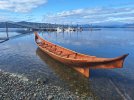Jason Rucker
New Member
Hello all,
I'm a lifelong wooden boat person, but have no canoe experience. I was a boatbuilder, curator and captain at San Francisco Maritime National Historical Park, then sailed around the Pacific with my family on a wooden ketch. At the end of that trip I met Stormy Hamar, of the Haida Canoe Revitalization Group. Since then I've been working with HCRG to research historic Haida dugout canoes and to make 3D models and lines drawings of them in Alaska.
Friday, September 5 at 1:15pm, Stormy and I will be presenting on our work at the Port Townsend Wooden Boat Festival. If any of you ate attending the festival, I hope to get a chance to meet you there!
(The attached photo is Stormy’s 30' western red cedar Haida canoe, launched May of last year.)
I'm a lifelong wooden boat person, but have no canoe experience. I was a boatbuilder, curator and captain at San Francisco Maritime National Historical Park, then sailed around the Pacific with my family on a wooden ketch. At the end of that trip I met Stormy Hamar, of the Haida Canoe Revitalization Group. Since then I've been working with HCRG to research historic Haida dugout canoes and to make 3D models and lines drawings of them in Alaska.
Friday, September 5 at 1:15pm, Stormy and I will be presenting on our work at the Port Townsend Wooden Boat Festival. If any of you ate attending the festival, I hope to get a chance to meet you there!
(The attached photo is Stormy’s 30' western red cedar Haida canoe, launched May of last year.)

